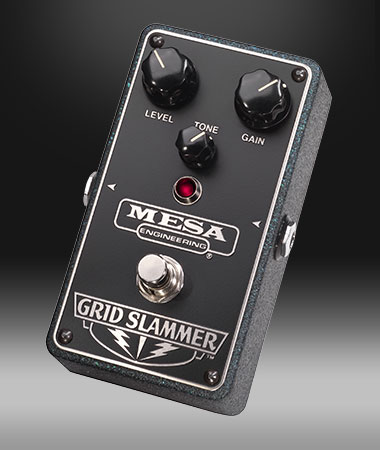The Grid Slammer from Mesa Boogie
Specifications from Mesa Boogie’s website
- Dimensions (W/D/H): 2.87″ x 4.77″ x 2.28″ (73mm x 122mm x 58mm)
- Weight: 0.731lbs (332g) with battery, 0.631lbs (287g) without battery
- True Bypass Switching
- Battery Type: 9VDC (one)
- Power Consumption (Current Draw): 9VDC/15mA
- AC Adapter (Optional): Power Jack 2.1mm x 5.5mm, 9VDC with Negative Center (Regulated Recommended)
- Input Impedance: 1M Ohm (500k Ohm minimum)
- Output Impedance: 10k Ohm
Grid Slammer Review
My friend at StudiOwz recently acquired this pedal, which I had seen online and recommended he check out, as he was in the market for a new overdrive pedal to go with his other new toy….a 1974 Fender Twin. I’d stumbled across a great video on Mesa’s website while looking for different pedals for him, and I loved the sound of this Grid Slammer pedal. The guy in the demo video plays great as well, check it out:
So, it arrived, and this evening we put it through it’s paces with the kit available to us. The rig we used was: Danelectro ’59 & Fender Custom Shop Strat guitars, into the pedal, then into the amp. We also tested a fuzz pedal between the Grid Slammer and the amp, but more on that later.
First Impressions and The Basics
My first impression when I saw it was “that looks really cool”. Made from metal, built to last and with a subtle glass sparkle finish, it looks the business. On picking it up, I was pleased to feel how weighty it was. Not so heavy to put you off adding it to your pedal board, but sturdy enough to know it’ll take a hammering and be absolutely fine without a doubt.
The Grid Slammer is fairly basic in it’s layout: Volume, Gain and Tone are all you get, but trust me when I say you really don’t need anything more with the tone from this box. The Volume control is simple, for balancing the level when the pedal is on with the level when the pedal is off, or boosting depending on your requirements. Gain is the amount of drive provided, from pretty much clean to a rich, driven, bluesy lead tone which also works well as a medium/heavy rhythm guitar sound. Tone basically controls the level of brightness in the distortion sound, and is very musical and usable especially in the middle 1/3 of the control.
Grid Slammer Sound Test
I don’t profess to know a lot about gear, I have a working knowledge base, nothing more, but the overriding impression that struck me was that this is a REALLY great sounding pedal. When I hear overdrive pedals, many sound quite cheap to my ears, even when the price tag says otherwise. There can be a synthetic texture from lots of them, so unless they are really well made the cheapness will only be enhanced by a quality amp such as a Twin. Sometimes that sort of sonic texture is also what’s needed, so those sounds shouldn’t be discounted out of hand. However, the Grid Slammer has a particular tonal palette, and a quality one at that. It does what it does, and shouldn’t be expected to do anything more.
With the gain at it’s lowest setting, it can effectively be used as a clean boost pedal to either raise volume levels for solos and lead playing, to drive the front of a valve amp that’s on the edge of breaking, or as a tonal change with the tone control altered. As the gain gets cranked, you really get into that lovely crunch territory, perfect for blues and tasteful lead fills, and up at the top end of the gain control you can really get into the classic lead tones. Think Stevie Ray Vaughan on Pride and Joy and you’re not far off. The coolest thing to me, is that everywhere we set the gain on this pedal, it always sounded good.
We then tried an experiment with a fuzz pedal between the Grid Slammer and the amp. That shocked me. With this drive pedal and a good fuzz pedal (we used a Russian Big Muff, but I’d have liked to try a Fuzz Face if we could have borrowed one), this pedal brought what can be a very temperamental and sometimes unruly fuzz sound massively under control. With a Fuzz Face, you’d be well into the territory of Eric Johnson or Jimi Hendrix’s lead sound, depending on your setup. I also have a feeling that this pedal into a high gain amp for metal or other heavier styles will fatten things up and give you even more grunt if you need it. It’s certainly a versatile little box.
The most impressive thing for me, was the way the pedal responded to dynamics in your playing. It was almost like a valve amp in this respect. With the volume of the guitar backed off, it cleans up brilliantly, and even if the guitar is at full volume it will still clean up if you play softer. Heading in the opposite direction, if you have it on a setting you like and lay into the guitar a bit more, it breaks in very much the same way a valve amp will. I’ve not really used many overdrive pedals which are this responsive dynamically, with the added benefit of the tones being really musically inspiring.
Conclusion
If you’ve got a good valve amp, and are looking for a great sounding pedal to drive it a bit more, the Grid Slammer is definitely one to try. It holds its own with any others I’ve tried in my time. If you’ve not got such a good amp, this is still worth checking out as it has the tonal quality to really add to your sound before it even hits the amp. Definitely worth the £150 or so you have to spend on a new one.

